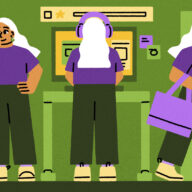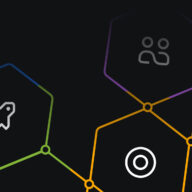How to have a genuinely good day working from home
Family and friends ask, “How was your day?” or “How was work?” and instinctively, it’s easy to answer with “Good.” But was it actually good? What is a good day?
Did you make it “good” or was it just another day where nothing went wrong? As an early career-er, I’ve decided to prioritize finding joy and creating balance in my work days so when people ask how my day was, I can confidently say I had a genuinely good day.
That being said, my days rarely go as planned. Life just never seems to stick to the time-blocked schedule I made in my head (or my Google Calendar). With that in mind, I’ve developed my own WFH strategies that still allow me to feel accomplished and happy at the end of the day, no matter what happens.
While the blueprint for the perfect day doesn’t exist because well… s#!t happens, here’s how to get pretty close to it.
You need a morning routine
Icebreaker time!
Raise your hand if you’ve ever slid out of bed 20 minutes before your first meeting, threw yourself together, and haphazardly started your day.
*Guilty*
Next thing you know, it’s 1 p.m., you haven’t had breakfast, and you are officially hangry.
How you start your day sets the tone for the type of day you have. Picture your mornings like those big tugs you make on a lawnmower string to get it started. Your morning is there to kickstart your day—it should fuel you.
Having a morning routine spares you from the decision fatigue you get from trying to decide what to do first. While everyone’s preferences look different, the best part about a morning routine is how it’s customizable to you!
For me, my mornings = me time. I choose to take care of hygiene first thing—brushing teeth, washing my face, the works! I’ve learned that quiet time is super important for me as well, so I’ll spend 10-15 minutes reading, writing, or meditating. I also try to make my bed every morning because having a clean space feels like having a blank slate to my day. Post-quiet time, I make tea, get dressed and ready, and pop open the laptop to “clock in.”
Whether it’s an hour or just 10 minutes to yourself, that pocket of time makes a difference. Allow yourself time to actually wake up, prepare (breakfast, notes, or kids) and get yourself oriented for the day ahead.
Plan your day
Mental or written, we all have that really long brain-dump list of things to do just sitting somewhere (mine lives in Trello). If you’re like me, you chip away at it here and there, but it sort of just lives in an ethereal backlog.
Enter: the “Top 3 To-Do List” strategy. This strategy entails making a daily to-do list with only three items on it. Ask yourself, “Even if today becomes a hot mess, what do I absolutely want to accomplish?”
The daily top-three list allows your brain to focus on just three things. These items can be pulled from your backlog or they can be new and current items. For those of us with priorities in different areas of life (work vs. home vs. family), having a couple separate top-three lists might provide more benefit—one for work, one for home, one for personal. Tweak this system to your needs, but the key is to focus on just a few items you know you can accomplish for that day.
Whether it’s this Daily Task Management template or the sample in the GIF below, you can make your own board with custom labels and due dates that are perfect for separating priorities and choosing items for your daily top 3 list.

After planning out what you’d like to accomplish for the day, the next step is to forecast how much time is needed for each task. Incorporating large blocks of recurring, daily focus time seems like it should work (and it usually does work for me… for about a week) but, often, it slowly becomes this ignored chunk of time on my calendar.
Try this instead:
- Think about how much time each item on your to-do list will take.
- Schedule these tasks as blocks of time on your calendar and name them after what you’re doing. (So instead of naming it “focus time,” name it “marketing audit.”)
However, it’s important to make sure you’re setting yourself up for success. If you know auditing marketing materials will take two hours, don’t just schedule a two-hour time block on the calendar. Let’s be real, some of us can’t do one task for two hours straight without needing a breather (me). Instead, break this task down into more realistic and digestible chunks. Scatter four half-hour chunks across the next two days (or just two, one-hour chunks)—however you decide to divide your time.
These small time blocks are meant to be moved around to accommodate life when s#!t happens. If you were supposed to analyze market data at 2 p.m., but an impromptu huddle sesh with your teammate took until 2:15, simply move that time block for analyzing market data to a free space on your calendar. Move it, but don’t lose it.
Let’s not forget about lunch, snack, and mental breaks—it’s important to schedule these, too! They’re beneficial to you and to the company as well. Taking a break from work increases energy, relieves stress, and increases focus when you return to work which, as a result, improves productivity.
Food and mental breaks are usually impromptu for me since I need them at different times each day. On meeting-heavy days, I’ll schedule them on my calendar as a reminder in case I get so busy that I forget to feed myself.
Have a soundtrack
Why incorporate tunes and a good pair of headphones into your work routine? Because believe it or not, you can get distracted by silence. Listening to music while working can provide a rhythm for your workflow because it blocks out background noise and distractions. It also helps lower stress, aids memory retention, and can even boost motivation.
There are so many acoustic options to help keep you focused and in the zone: white noise, ambient sounds like waterfalls, jazz, lo-fi, or even house music—whatever suits your ears (and brain). It’ll take some trial and error to find yours.
My go-to is low fidelity (lo-fi) music (and fellow lo-fi lovers might enjoy this Chill Beats playlist). Another all-around good playlist for 9-5 jams is Workday Lounge on Spotify. You may also want to check out our list of science-backed productivity playlists.
Lo-fi, specifically, boosts brain activity. Studies show that the non-lyrical aspect of lo-fi contributes to higher recall and allows the brain to engage in deeper cognitive processing and information retention. Press play and get your WFH groove on!
Accommodate personal priorities
Working from home comes with the luxury of finding and creating balance. Being at home allows you to attend to non-work related needs like family, home, and personal things. The beauty of WFH is that you can incorporate these things into your work day.
You can commit yourself to your personal life the same way you do to work. Steven Kramer, psychologist and author of The Progress Principle, says, “Schedule your time with your family and with yourself… Put those on your daily calendar as seriously as you would your work.” Here’s a sample of what this could look like:
Let’s say your priorities looked like this:
- Being more mindful
- Eating healthy
- Quality time with loved ones
Then your schedule might include these things:
- Spending 15 minutes meditating or practicing yoga
- Allocating time to juice your fruits and vegetables in the morning
- Catching up with family or friends every week on Wednesday evenings (and call it #WeeklyWednesdays to make it a thing)
You have your 9-5 all mapped out and scheduled for you. It’s up to you to decide what your 5-9 looks like.
*Work-life balance has entered the room*
Your priorities don’t have to be centered around attending to your mind, body and soul, but that’s a good place to start if the ultimate goal is balance. For me, having a creative outlet is important, so I make sure I have something that keeps me creative in my day. (Luckily, work fulfills that need for me.)
It’s time to raise the bar on how you define a good work day! Reframe your day with these strategies to have a satisfying day that includes breaks, focus time, and lots of good vibes.










































